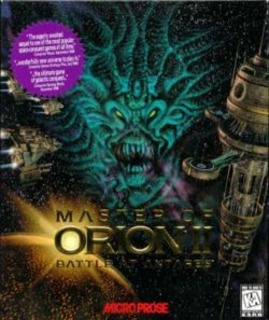Master of Orion II is an amazing title that has yet to be (completely) surpassed.
Such is my love for Master of Orion II that I have literally collected spare copies of it over the years, if for no other reason than to ensure that I am never without it again. As great as Master of Orion was, the sequel is better. The design of the game was improved in almost every way - with just a few exceptions - over its predecessor, yielding an experience that is bigger, flashier, deeper, and far more intense.
We got to play the same races we were already familiar with, plus three new ones, and even create our own if we wanted - one of the first 'mainstream' 4x games to do so. The tech tree was streamlined and research became much more transparent; diplomacy was improved in much the same way. Colony management went from an abstract system of sliders and piles of factories, colonists and missile bases to a functional colony screen where every structure had a specific purpose, and colonists could be allocated directly from one work area to another. Stars ballooned from single-planet entities to full-blown systems with multiple planets and asteroids, exponentially increasing the size of your empire and making it possible to rub elbows with your alien neighbors in a much more literal sense. We were able to hire a motley assortment of colorful leader characters that gained their own levels - only eight, of course, but they could certainly make a good colony great or transform a powerful fleet into a nigh-unstoppable armada. And of course, there were the Antarans - the original 'big bad' that many modern 4x games now have as a matter of course. Their ominous pop-up arrival cinematic was often followed by groans as you realized that they were on their way to nuke yet another of your hard-built colonies.
Many of the original game's core mechanics were left intact, and were simply upgraded with better graphics and new technology, making things run more smoothly. The dynamic nature of the game was preserved, with rampaging space monsters, random events, and the ubiquitous GNN news reports taking center stage. While there were fewer types of planets, the number of planetary specials was expanded, and colonization and terraforming were made easier.
A few things weren't quite as effective. Espionage, in particular, was randomized, rather than being specifically targeted by the player (more realistic, perhaps, but leaving players with a less strategic option). The number of possible ship designs was sliced down from six to five (not a major reduction, but enough to limit another of the player's strategic options). And the new sheer size of the galaxy, with its possibly quintupled number of planets, involved a great deal more micromanagement of colonies and fleets.
Its few structural and gameplay flaws aside, Master of Orion II is still a masterpiece by any standard - it is still played in online multi-player matches to this very day. Sadly, the third game in the series didn't deliver the groundbreaking changes that the middle installment produced, and so MoO2 still remains the gold standard. While some games produced in recent years have delivered variations of the features that were introduced in Master of Orion II, I personally have not yet played the modern 4x game that seemed to combine them all into the unique blend that MoO2 somehow managed to deliver.

